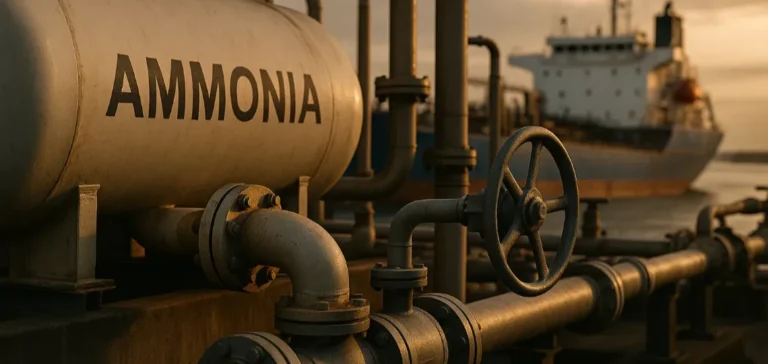The maritime transport industry is at a turning point. The majority of the global fleet still runs on fossil fuels, but new rules from the International Maritime Organization (IMO) will impose binding emissions reductions starting in 2028. In this context, low-carbon ammonia—whether produced by electrolysis powered by renewable electricity (“green ammonia”) or by natural gas reforming with carbon capture (“blue ammonia”)—is attracting attention as a future marine fuel. However, its adoption faces a series of financial, technical, and regulatory hurdles that are slowing down its deployment.
Production costs remain prohibitive
The first obstacle to the rise of ammonia as a marine fuel lies in its price. The production cost of green ammonia averages around $730 per tonne, nearly three times the cost of conventional fuels used in shipping today. Even blue ammonia, produced at around $600 per tonne, remains well above the market prices of fossil fuels, estimated at $500/tonne for heavy fuel oil. The gap is even more pronounced when comparing the actual energy provided: ammonia has a lower energy density, which increases the volume required for equivalent propulsion.
Cost reduction prospects largely depend on improvements in electrolyzers and the availability of ultra-low-cost renewable electricity. In regions with abundant solar and wind resources, such as the Middle East, costs could fall to $480/tonne by 2030. However, in Western Europe or Southeast Asia, where electricity remains expensive and renewable production constrained, such competitive prices seem out of reach in the near future.
Uncertainty over infrastructure and investment
Beyond production, transporting and storing ammonia requires dedicated port infrastructure. Few ports today have bunkering facilities suitable for this molecule. Investments to build dedicated terminals, secure pumping systems, and corrosion-resistant tanks are expected to be substantial. Shipowners also need to adapt their engines. Several manufacturers, such as WinGD, are already working on “ammonia-ready” engines, but large-scale deployment remains embryonic.
The cost of retrofitted or new vessels, combined with uncertainty over future demand and regulations, weighs heavily on investment decisions. Financial institutions and shipowners are calling for clear political signals before committing capital to this transition.
Toxicity requires strict safety standards
Ammonia is a toxic and corrosive substance, which poses a major challenge for its use as a fuel. Industrial accident databases list more than one hundred ammonia-related incidents in Europe and the United States, often due to human error or equipment failures. At sea, twelve accidents involving vessels carrying ammonia were recorded between 1978 and 2021, several of them fatal.
Onboard, direct contact or inhalation at concentrations above 300 ppm causes serious injury, while exposure above 5,000 ppm can be fatal. Detection systems, compartment isolation, and ventilation must therefore be reinforced to minimize exposure risks. The International Code of Safety for Ships Using Gases or Other Low-flashpoint Fuels (IGF Code) is expected to be amended by 2026 to incorporate ammonia-specific requirements.
Environmental risks under close watch
Unlike fossil fuels, ammonia does not release carbon dioxide during combustion. However, it produces other concerning pollutants. The formation of nitrogen oxides (NOx) and nitrous oxide (N₂O)—a greenhouse gas nearly 300 times more potent than CO₂—remains a technical challenge. Selective Catalytic Reduction (SCR) systems can limit these emissions, but their effectiveness under large-scale use of ammonia in marine propulsion has yet to be proven.
In addition, leakage or “slip” during storage or combustion raises concerns for air quality and crew health. In marine environments, dissolved ammonia can disrupt ecosystems, cause fish mortality, and contribute to eutrophication in coastal areas.
A regulatory framework under development
The adoption of ammonia as a marine fuel depends not only on technical and economic feasibility but also on international law. In April 2025, the IMO approved a draft “Net-Zero Framework” requiring ships over 5,000 gross tonnes to progressively reduce the carbon intensity of their fuels starting in 2028. The framework will include a system of quotas and penalties, with the possibility of generating or purchasing offset units.
Meanwhile, the European Union has already included shipping in its Emissions Trading System (ETS) and introduced the FuelEU Maritime regulation, which sets a maximum carbon intensity for the energy consumed per ship. If both IMO and EU rules coexist, shipowners may face compliance with two different regimes, complicating fleet management.
Outlook for industry stakeholders
Faced with these constraints, industry players are moving cautiously. Pilot projects are multiplying but remain small in scale. Engine manufacturers continue research, while some strategic ports, particularly in Europe and the Middle East, are considering establishing ammonia bunkering facilities. However, the economic balance of low-carbon ammonia will not be reached without support policies such as tax credits, subsidies for clean hydrogen production, and carbon pricing mechanisms.
For shipowners and investors, the question is no longer whether ammonia will become an option, but under what conditions and on what timeline it will compete with other alternative fuels such as methanol or liquefied natural gas with carbon capture. Strategic choices made in the coming years will determine ammonia’s actual role in the global maritime energy mix.






















